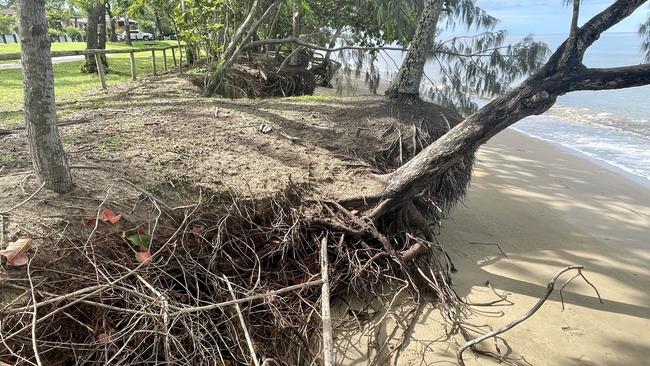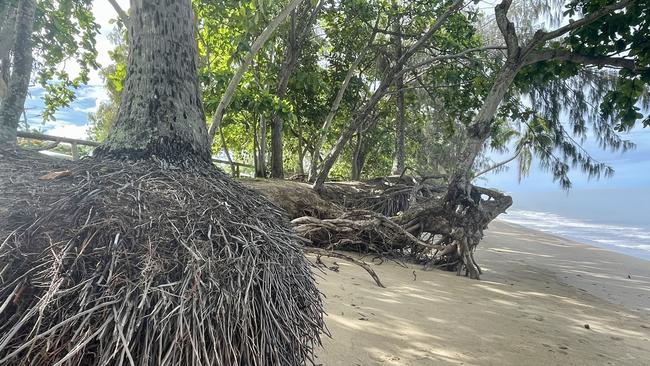Holloways Beach still slipping into Coral Sea after groyne build
Council has been urged to rethink a sand stabilisation plan after a multimillion dollar spend failed to save a suburban Cairns beach from being washed away. Photos reveal the power of the ocean.
Cairns
Don't miss out on the headlines from Cairns. Followed categories will be added to My News.
A popular Cairns beach is slipping away into the sea despite a $2m outlay in 2020 to build two groynes aimed at preventing erosion.
At Holloways Beach, north of Cairns, much of the beach is blocked by barriers and its sand is disappearing into the Coral Sea.
Over two years ago Cairns Regional Council completed the construction of two rock groynes at the beach to help stop erosion, but the problem has not gone away. Public access is now fully restricted by temporary fencing from the public toilets to the end of Casuarina St.
In August 2020, the council completed the construction of the two 30m rock groynes at the cost of $2 million, with the intention to improve the beach amenity and provide long-term protection of the foreshore.

But two years later the beach is once more being washed away, leaving trees struggling to stand even in the absence of major weather events such as cyclonic storm surges.
Paul Aubin has lived at Holloways Beach for 24 years and provided insight during the consultation process.
“We haven’t seen much change with the beach once again being heavily eroded,” said Mr Aubin.
“When they did the consultation, the plan suggested groynes twice as long those that were installed that would better stop the migration of sand from the south, north.
“There were also suggestions of there being a total of four groynes starting from Machans which could also have the effect of keeping Barr Creek open to the sea.”

Mr Aubin suggested taking a look back at original engineering suggestions.
“It’s a difficult situation, one possible measure could be to lengthen the current walls or create a T like section at their ends to distribute energy from waves,” he said.
“I think the council may have been too constrained and need to go back to that consultation.”

In the absence of new structure Mr Aubin said the short term answer would be replenishment.
“The trouble is the sand needs to come from somewhere but there are options for dredging from known sand deposits such as the mouth of the Barron as well as towards Thomatis Creek.”
Cairns Infrastructure and Assets Director Mark Wuth said that the sand erosion at Holloways has been an ongoing concern for decades.
“The groynes generally provide benefit to the south of the playground, where there is a greater need due to the risks to community infrastructure,” Mr Wuth said.
“Council does continue to provide sand nourishment to the northern end of the beach to help protect vegetation.
“As part of the Shoreline Erosion Management Plan, also developed in 2021, Council plans to install rock headlands at Holloways Beach and Clifton Beach.
“These are physical structures placed near the shore, running parallel to the beach, which mimic naturally occurring rock formation to encourage sand retention.
“They have proven successful in other parts of Queensland and abroad, and will reduce the frequency and cost of sand nourishment, as well as retain the beach’s amenity for users.”
Council intends to initially install three headlands at both beaches, following the obtaining of relevant approvals.
More headlands will be constructed pending a performance review of the initial structures.
Beachgoers are reminded to heed warnings and not to enter areas barricaded due to erosion.
“Due to the constant shifting nature of beach erosion, barriers remain the most appropriate device to provide safety to the public, as they are not permanent and can be easily moved as required.”

Groynes have worked for other Cairns beaches in the past, according to long-term Holloways Beach local Mr Aubin.
“An example of a groyne being very effective is at Yorkeys,” he said.
“The sand was eroded to the road but after the installation of the longer groyne 100m of sand has built up.”
While groynes may not be a pretty solution Mr Aubin said their use could be maximised as a community asset.
“They aren't a pretty or a natural thing but they can be turned into an asset by making them user friendly for fishermen by flattening them off and providing access,” he said.
“It’s quite a popular as the first tropical beach out of cairns and we would hate to see it washed away with no beach access.”
More Coverage
Originally published as Holloways Beach still slipping into Coral Sea after groyne build




